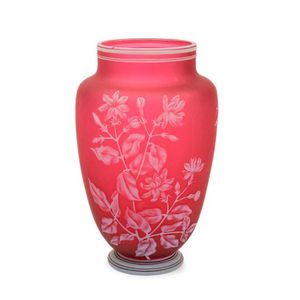Webb & Sons Cameo Glass Vase with Honeysuckle and Butterflies
You must be a subscriber, and be logged in to view price and dealer details.
Subscribe Now to view actual auction price for this item
When you subscribe, you have the option of setting the currency in which to display prices to $Au, $US, $NZ or Stg.
- Acid Etched - Acid etching is often used on glass, metals, and stone to create decorative finishes or to prepare the surface for further treatment or coating. The process of acid etching involves applying an acidic solution, such as hydrochloric acid or nitric acid, to the surface of the material and allowing it to react with the surface. The acid etches away a thin layer of the material, creating a rough, uneven finish. Acid etching can be used to create a variety of different finishes, from a subtle matte finish to a more pronounced, textured finish.
- Circa - A Latin term meaning 'about', often used in the antique trade to give an approximate date for the piece, usually considered to be five years on either side of the circa year. Thus, circa 1900 means the piece was made about 1900, probably between 1895 and 1905. The expression is sometimes abbreviated to c.1900.
- Etched - Glass decorated with an etched design, which is achieved through marking out the pattern, protecting the area that is not be etched, and then immersing the object in acid to dissolve the surface of the unprotected area. With some glass objects, such as cameo glass, there may be several layers of different coloured glass, and part of the top layer is dissolved leaving the bottom layer as the background. The longer the time of exposure of the object to acid, the deeper the etching.
The word etching is also sometimes used to describe another method of decoration, where wheel grinders were used decorate the surface, but this technique is usually known as engraving.
This item has been included into following indexes:
Visually similar items

Japanese Cloisonne vase decorated with two-tone pink roses on yellow ground. Height 25 cm

Blue Fenton art glass vase hand painted with dafodils onto a Blue.purple glass field, signed to base, and sticker to side, height 23 cm, cm, diameter 14 cm

Japanese cloisonne floral vase on a red fish scale & bamboo type ground. Condition good, minor staining to the silver plated rims. Height 24.5 cm

A Japanese Kutani earthenware vase, shouldered shape with cylindrical neck, decorated in multiple shaped panels with figures in garden landscape; birds in flight amongst the blossoms and other various florals, on an iron red ground highlighted with floral
